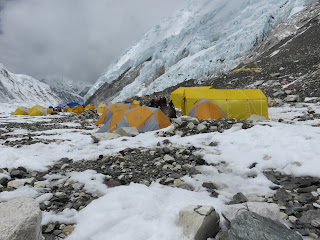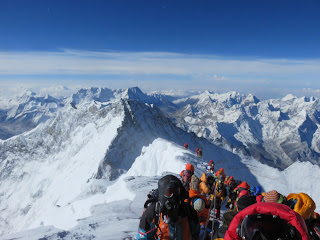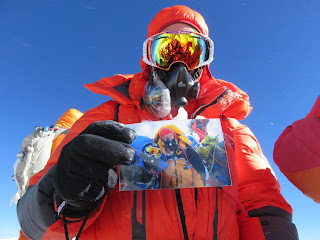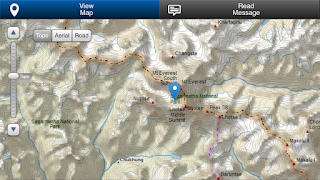After all the pictures were taken, after I'd had one last look at the view I had dreamt of for 39 years, after I had given myself one more moment for it all to become as real as possible, it was time to descend. There are far more accidents on the descent than the climb up and I was very much aware of this.
HAPE and
HACE are two of the biggest enemies of high altitude climbers and they can only be held temporarily at bay with modern drugs; the only real solution is a rapid descent.
With the perspective of a few days to review what happened, I believe I was already in the early stages of both of these killers although I didn't really realize it while I was enjoying the summit. Our climb back down to the South Summit should have taken us 15-30 minutes but instead it took more than two hours. Again, the principal problem was the crowds. Passing those going the opposite direction was painfully slow and there were times when I couldn't move for ten or more minutes. In talking with my teammates, we concluded that we lost about three hours on the ascent due to the overcrowding and I think I lost at least another 90 minutes just retreating to the South Summit. Those precious minutes almost cost me my life.
By the time I arrived back at the South Summit things were rapidly falling apart in my body. I had lost all of my strength and found my breathing to be extremely difficult. I spent the rest of the descent setting tiny goals of 30 steps between rest breaks. Most of the time I couldn't come close to the goal. This left me making 10 to 20 steps before I was forced to sit for several minutes and breathe as though I was sucking through a garden hose. Fifty hard breaths would seem to make no difference for me in spite of the fact that I was sitting still.
With Pasang Oongchu leading just in front and Sange just behind, we made our way down the mountain very slowly. It was as though someone was suffocating me with a plastic bag. Air just couldn't fill my lungs. I was also incredibly thirsty and would scoop up bits of snow each time I sat down and swallow them for a little moisture. This snail-like progress continued for hours. On multiple times I would think "if I could just sit here until I feel good again..." but then I would shut out the thought because I knew sitting for a longer time really meant sitting forever. I focused on Patty and my kids as hard as I could and they became my reason for getting down.
As we neared the Balcony we found a young Sherpa with a large load who had fallen off the rope but fortunately landed on a flat area. He was dazed and just sitting there with no idea of what to do next. Pasang Oongchu once again stepped into action and pulled him onto his feet and helped him down the mountain while also tending to me.
At some point not far below the Balcony, I was getting too tired to stand so I decided to glissade down. This is a fancy climber's term for "slide on your butt". I remained clipped to the safety rope and simply slid slowly down the snowy slope on my rear end. I also noticed that Sange was starting to really fade badly. I couldn't abide the thought of his young son never seeing his father again so I pleaded with him to go ahead. He finally, reluctantly agreed and I watched him move further away from me as he went much faster than I could.
I reached the bottom of the Triangular Face, the last of the steeper portions above C4, and could no longer glissade. My next big worry was if I could find the strength to stand up again? And if so, how could I walk the half mile to my tent? The distance looked so great that it might as well have been a thousand miles. Pasang was once again right at my side. He helped me up. He put my arm around his shoulder and he slowly and patiently walked with me on the mostly gentle slope to the camp. We would stop every few yards and I would sit and gasp. He would patiently wait until he knew it was taking too long. At this point he would gently speak my name and I knew it was time to go again. The down climb should take 4-5 hours in total but I was eleven hours into it and still not at camp.
The one piece of good news up until this point is that everything was downhill. This changes for the last 100 yards where the route goes flat and then makes a very small climb up to the tents. I looked at that tiny ten foot high hill and lost all hope. Uphill simply wasn't possible. I sat down for a long time and in spite of Pasang's urging I couldn't find the strength to stand up. When it became all too clear that I'd reached my limit, Pasang left me and went ahead to our camp for help.
I apologize to those who helped me next, but my state of mind was far from normal and a lot of the details are blurry. Some people (Sherpa?) brought me tea and food but as hungry and thirsty as I was, that was not what I needed. I declined their offer. Eventually someone decided to change out my oxygen bottle. I don't know why because I was still getting Os. Regardless, they fumbled the switch and couldn't reconnect me to the gas I so desperately needed. I fell onto my side and started spasming and I remember clearly thinking, "Okay, so now I know exactly when and where I will die. I have only a few seconds left and then the pain goes away."
Somehow another 60 or more seconds passed and I again felt the life-giving oxygen hit my lungs. Maybe I won't die now? I didn't know and was to a point where I was really not very concerned either way. I mostly just wanted to stop hurting. They told me to stand up and they would help me to my tent. All I could do was sit on the snow and shake my head no. I had lost my voice and was unable to tell them what I needed. I knew I had HAPE and likely HACE. I knew I needed to get down but given the fact that it was almost dark I knew that was impossible. I tried using sign language to indicate I needed a
Gamow bag and a
dexamethasone injection but no one was understanding me.
Once it became clear that I would not be covering the last 100 yards under my own power, six people hoisted me up and dragged me like a dead man to my tent and rather unceremoniously tossed me inside. At some point during this process Ben and Laura Darlington reached me. They are a young couple from Canberra, Australia and are part of our small Altitude Junkies team. They immediately saw the gravity of the situation and were actively getting out the dexamethasone (Dex) injection that Phil had given to all of us in base camp. Ben is an electrician and Laura is an accountant - just normal people, not medical professionals. But they are smart and capable and knew exactly what needed to happen.
Just as they were preparing to administer the first injection in their life, Billy Nugent appeared. He is a professional guide with
Madison Mountaineering and although not a doctor, he does have more training and experience than any of our team has. He later confided with Ben that he believed I would be dead within a few minutes. Billy and Laura crawled in after me, pulled my coats and shirts off my shoulder and I was rapidly injected with the powerful steroid. The results are pretty immediate and significant and it was a bit like coming back from the dead. I was still far from capable of doing anything to save myself, but I wasn't going to die in the next handful of seconds.
(Side note: some of you may be wondering what happened to Phil Crampton in all of this. Well, as we reached Camp 4 on the 17th, another member of our team developed HAPE. Phil was observant enough to spot this problem very early and escorted him back down to base camp, giving up his likely 8th Everest summit to save this man's life. He was in no way derelict in his duties but rather took the correct course of action given the events and information available at that time. Phil left no stone unturned in his efforts to coordinate my rescue from base camp.)
Ben and Barbara, our remaining team members along with Sange joined me in the tent. I was buried in sleeping bags to warm me and everyone assumed a key role in saving my life. Sange held me in a seated position because if I should lie down I would essentially drown. Laura handled all the medicines, keeping track of what I received and when. She also kept my head from falling off to one side or another and made sure I stayed awake. Ben handled the very difficult radio communications with Phil at base camp. The radio couldn't make the distance to base camp so he held the antenna up against the tent poles for hours in the cold and messages were relayed via Lysle, another teammate who had managed to reach C2. Barbara kept on top of hydrating me. I could only take the smallest sips of water without feeling like I was going to drown because I needed to remove my mask to drink.
Sange was in no shape to hold me up so he switched positions with Mingma who sat back-to-back with me for an hour or more. But this wasn't fair to him either so we finally found some mattresses and put them against the tent wall. I leaned on them through the night and Laura would hold my head for hours. We sat patiently all night long in the cold and dark. We tried to encourage each other and I tried to not die. If you need proof that these heroes saved my life, then look at the deaths of the Dutch gentleman and Australian lady the following day. I obviously wasn't with them but reading their stories makes me believe we were all suffering from the exact same problems. I will live the rest of my life in deep gratitude for what Ben, Laura and Barbara did for me that night in a small tent on Everest's South Col.
Fortunately the morning had reasonable weather and we were able to descend to C2. Another night at C4 would have definitely proven fatal for me. I was extremely weak and could only walk for less than a minute between much more sizable rests. While Sange and the rest of our Sherpa staff broke down our camp and carried 70 to 90 pound loads, Pasang led me down the Lhotse face. He was never more than a step or two in front of me and did all the clipping and unclipping of my safety line for me. His steady pace and capable hands were very comforting.
Meanwhile, behind me was Ben Darlington. Like Pasang, he was only ever one step away from me. At tremendous personal effort, he would hold his right hand out and lift my pack from my shoulders for much of the way down the face. This steadied me and eased my burden. I have never experienced such assistance in the mountains but it was so desperately needed and again I cannot thank these two men enough. There is no way I could have descended without their strength and skill. Once again I was owing my life to others.
The route from C4 to C2 has four main features. The first obstacle is descending the Geneva Spur and then dealing with the exposed traverse that almost stopped me on the way up. Fortunately there had been enough traffic that a bootpack had formed and the footing was much better. It was very narrow - six inches wide at times - but I was very happy to not be fighting for every step. This section should have taken 15 minutes but I needed two hours.
There is then a downward traverse to the Yellow Band which, although crowded, didn't pose too much of a technical challenge. It was just my extreme fatigue that I needed to battle. Next up was the Yellow Band. It had an endless line of climbers on the "down" rope so Pasang moved us to the almost empty "up" rope and we were down it without too much drama. To our dismay, some stranger hopped in between Ben and me. He was not a safe climber and failed to hold himself while descending. He ended up falling about 100 feet and we were alerted by yells from above and the horrifying sound of a human body accelerating towards us. I managed to barely get out of the way and brace myself and the rope that I was still connected to. Pasang had nowhere to go and took the full impact of this man. Miraculously no-one was injured and the rope held. This could have ended very differently with several of us falling well over a mile to the bottom of the slope.
 |
| The line of climbers above the Yellow Band. |
 |
| People above the Yellow Band. |
The biggest portion of the Lhotse face is a series of vertical ropes - I would estimate about 30 of them - that go all the way to the bottom. I actually found this the best for me. Pasang would connect my figure-8 to the rope while Ben would downclimb to the next anchor. I'd then rappel down, letting gravity do almost all the work and Ben would carefully guide me into the correct position to get off the first rope and onto the next. We repeated this process for hours and maybe 3,000 vertical feet until we finally reached the bottom of the face.
We knew I had almost no chance of walking the last mile to C2 from the bottom of the face so Ben, Laura and Pasang made arrangements for a rescue sled to be waiting for me and take me the final portion of the way. Six people came up with the sled and Pasang supervised the loading and moving of it. It was lightly snowing as we came into camp. These seven guys were all very tired and yet they took the utmost care with me. The route crossed two smaller crevasses and I was lowered down into them and raised back up on the other side. I knew I was in capable hands and never felt concerned.
We finally reached C2 after 12 1/2 hours of incredible effort. Everyone had given all that they had to make sure I arrived safely. We sat down for a quick bite of food and Ben collapsed asleep on the table. The relatively thicker air of 21,500' vs 26,000' was helping me and I was starting to feel a little better. I remember one of our rests on the face just above upper C3 when I told Ben that for the first time in 24 hours I knew I was going to actually make it. That was a seminal moment for me on the descent.
Phil had arranged to have Jason Laing (a New Zealander and renowned as the best pilot in Nepal) fly me from C2 at first light the next morning. He arrived right on time at 6:15 and twenty minutes later I was in Lukla shedding layers of clothing as I quickly overheated in the thick warm air of 9,300'. Jason dropped me off at the small hospital there while he returned to bring down several more injured people. There had been a number of HAPE cases and a lot of frostbite. After about two hours he returned for me and took me to Kathmandu.
 |
| Outside the Lukla hospital. |
There was an ambulance waiting for me at the helipad and it brought me directly to the highly regarded
CIWEC Clinic. They ran a number of tests on me and determined that I did in fact have both HAPE and HACE. Their advice was for me to spend at least one night in the clinic. Those who know me can predict what I did with that advice! Instead I went to the Hyatt and expected to recover quickly now that I had plenty of air, food and comfort. Unfortunately that is not what happened.
 |
| Looking good after a little climbing. |
I struggled for three days and nights and wasn't feeling any better. I finally gave in and returned to the clinic where they admitted me and I am now enjoying my third night in a hospital bed. The initial diagnosis ideas were all over the place as they tried to figure out what was causing my endless cough, fluid filled lungs, extreme weakness and general crummy feeling. The final decision is that I have bilateral pneumonia and they have me on antibiotics and a diuretic to remove the excess fluid in my lungs. I am finally feeling quite a lot better and expect to be officially released tomorrow morning.
Meanwhile, there is still more to the story. The long cold night in the tent at C4 gave Ben very serious frostbite on all of his right toes. He never said a word to anyone but just bravely and privately endured this nightmare. He helped me down for 4,500' on the Lhotse at tremendous personal cost. He then declined a helicopter ride from C2 and made his own way to base camp with Laura. It was only then that he told anyone of his own problems.
The following morning he was stretchered to the helipad in base camp and brought to the same clinic that I am in. He is undergoing a treatment with a very promising trial medicine that requires a six hour infusion every day for five days. I have spent as much time with him as my exhausted body will allow and I am blown away by his positive attitude and humble strength. Please keep Ben in your thoughts and prayers as he faces a huge battle to keep all of his toes.
Meanwhile the rest of our amazing team is all healthy and running around Kathmandu bringing us lunches and dinners and enjoying being back in the friendly part of the world.
There were some other players involved that I would like to recognize too.
IMG and particularly superstar guides Greg Vernovage and Justin Merle assisted with radio communications and donated the use of their rescue sled at C2. One of their clients also gave me a pill that I'd never heard of (New ???) that gave me a needed boost as we neared the end of the traverse below the Geneva Spur. Renowned climber and expedition leader Russell Brice of
Himex provided practical and communications support to me and to Phil Crampton. Trish Crampton spent several sleepless nights doing her logistical part in getting me to Kathmandu and ensuring I was properly cared for once I arrived here. No doubt there are other people that I am either not aware of or that I can't remember. Please accept my apology for failing to list you here and accept my deep gratitude for all you did.
There is always a lot of derogatory writing about commercial expeditions, the quality of their clients and support and the natural competition that business competitors are forced to engage in. I can honestly say from my close up perspective that I saw nothing but the highest professionalism from everyone involved. People forgot their business allegiances when they saw me in trouble and just stood up and did whatever they could to help. I am so proud to be associated with all of these people.
The bottom line for me in this story is that I have been given a second chance at life due to the bravery, skills, hard work and sacrifice of others. I feel like a soldier returning from battle after his buddies carried him through a hail of bullets. Were it not for Pasang Oongchu Sherpa, Sange Sherpa, Ben and Laura Darlington, Barbara Padilla, Lysle Turner, Billy Nugent, Phil Crampton, Jason the pilot, the doctors at the CIWEC Clinic, the six men who carried me to my tent and the six men who carried me over a mile in the snow and dark into C2 there is no doubt in my mind that I would be dead on the side of the mountain that has held my attention for 39 years.
 |
| Seven days after summiting. Ben and Robert. |



































